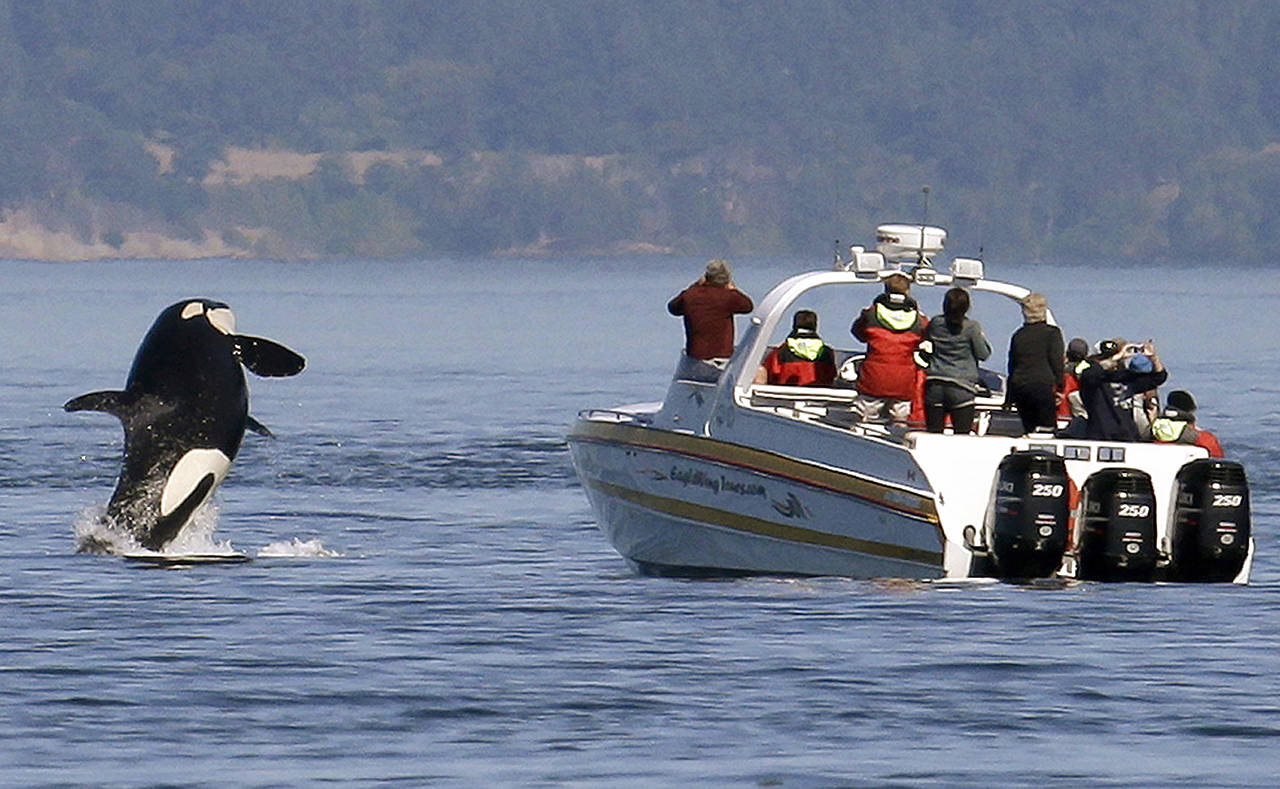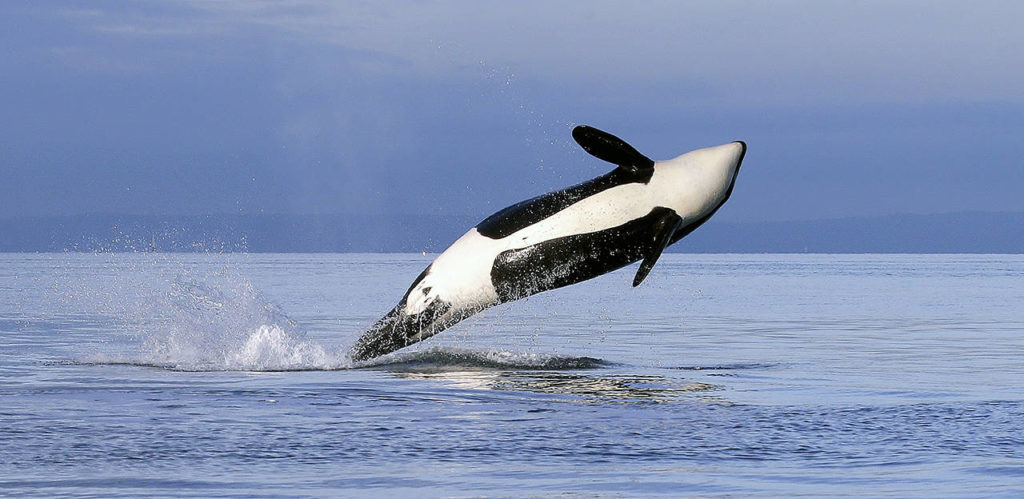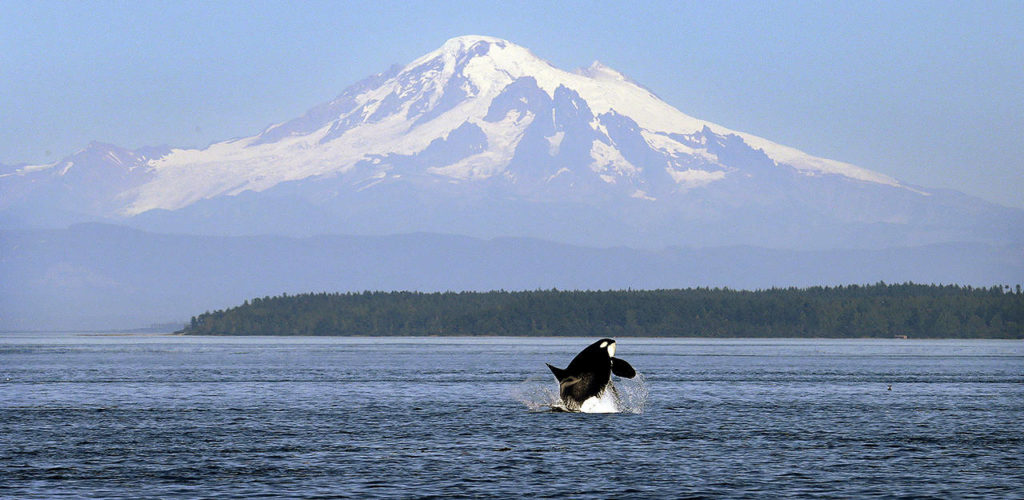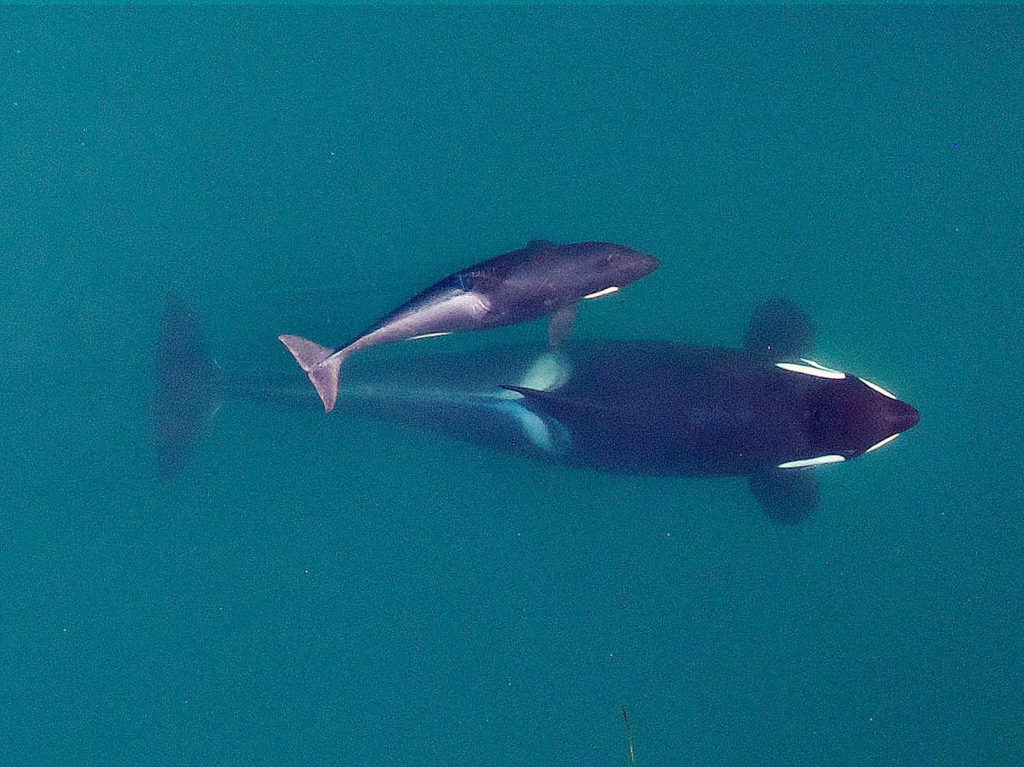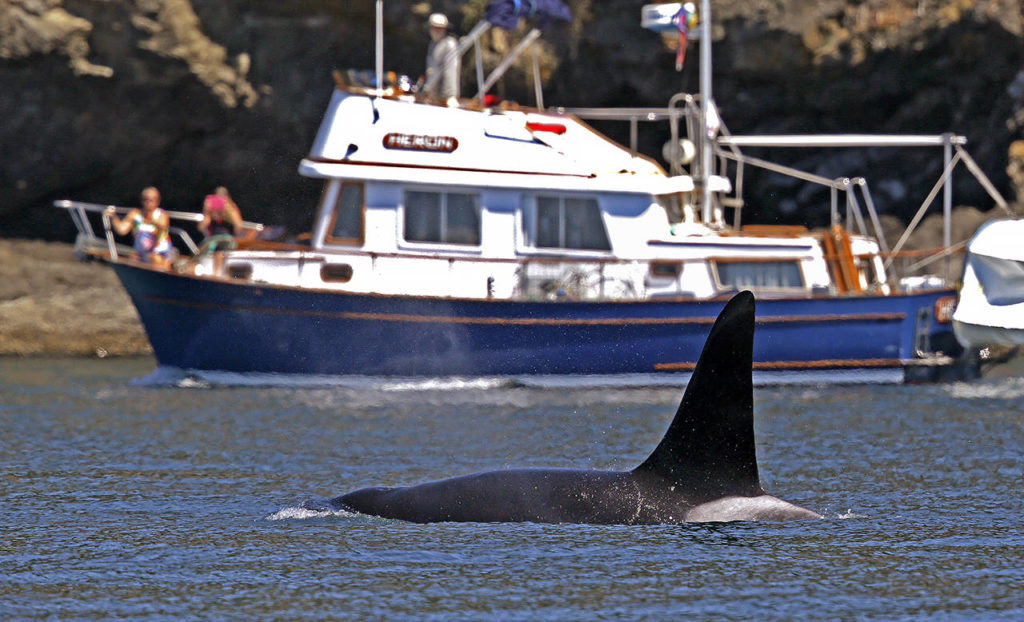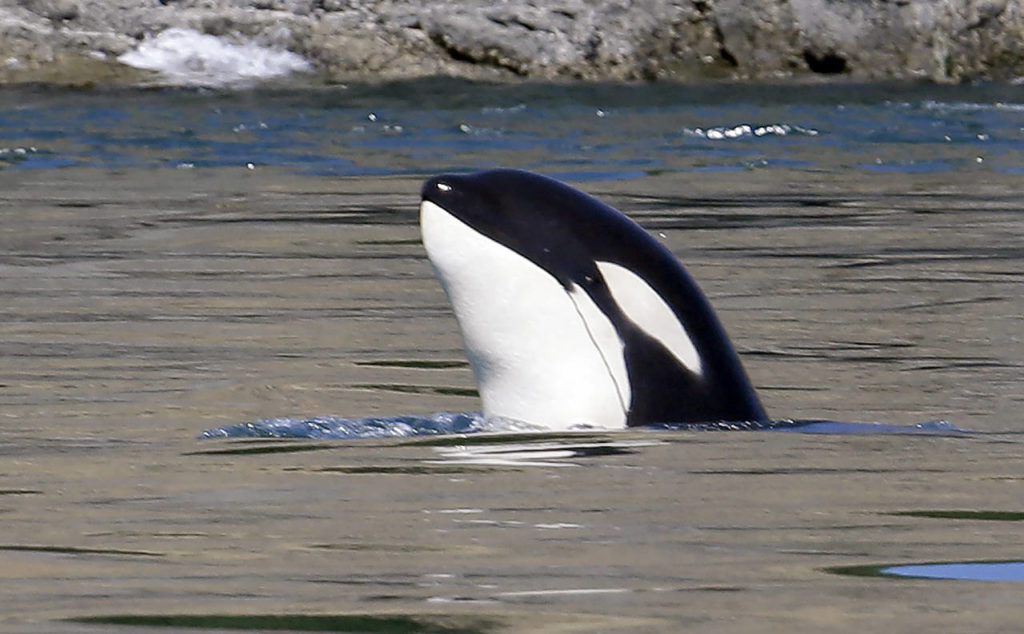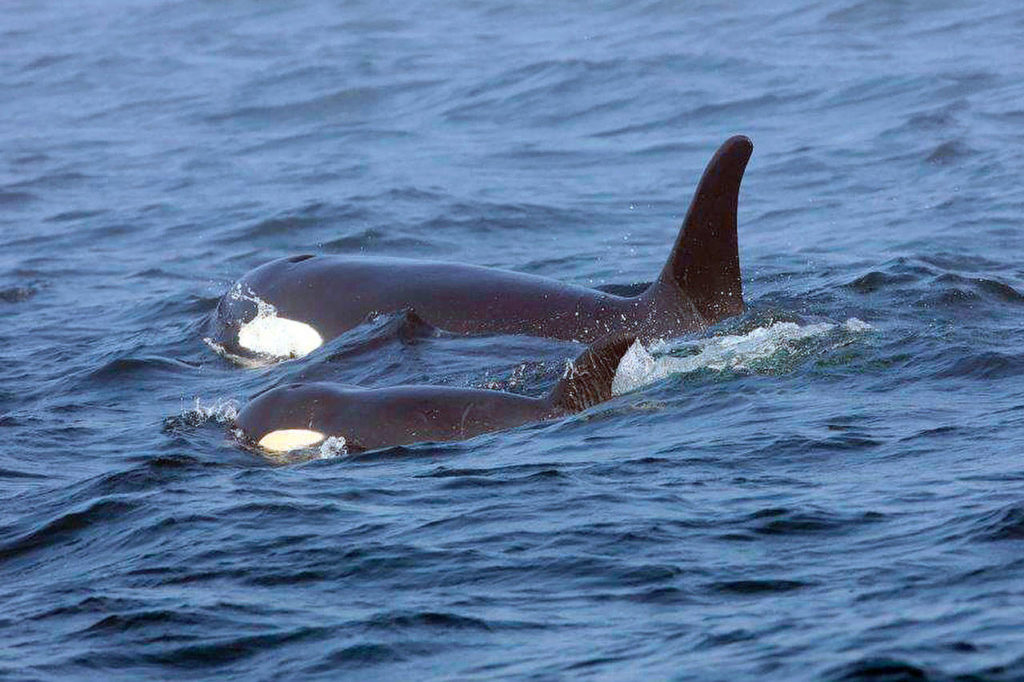EVERETT — Now is your best chance to see endangered Southern Resident Killer Whales back dive, belly flop and fin slap around Puget Sound.
Three orca family groups known as J, K and L pods make their way inland every fall to feed on chum salmon, a second-favorite to their preferred Chinook.
It’s a chance to witness a population that, despite millions spent on recovery efforts, continues to languish.
But state and local organizations say efforts to recover orcas’ main food sources are working — it’s just taking Mother Nature some time to catch up, and a growing human population through Puget Sound is presenting new challenges for already endangered species.
With two babies born into J Pod last month, the southern residents number just 74.
The population has fluctuated since the 1970s, when marine parks captured members of all three pods for display. The population was 71 orcas in 1974, the first year they were counted. The pods peaked with 97 in 1996, before declining again to the 70s.
“It’s a really low count for the whales,” Snohomish County Conservation District Executive Director Linda Lyshall said. “If we want to keep those species, we need to do whatever we can to help them rebound in their population.”
The southern residents were listed as endangered in 2005 under the Endangered Species Act.
Scientists have identified three main reasons the orcas can’t regain their numbers: a lack of food sources, pollution in the ocean causing immune or reproductive system dysfunction and noise disturbance from marine vessels.
In Puget Sound and locally in Snohomish County, much of the work to recover orca populations has focused on the first obstacle — a lack of the mammals’ main course, Chinook salmon.
“If there aren’t enough salmon, they go hungry,” Lyshall said.
When settlers arrived in Puget Sound, they diked off rivers and streams, drained estuaries and cut down forest. They put in bulkheads and railroads, hardening the shoreline that once housed the small fish salmon eat.
With fewer estuaries, juvenile salmon have fewer safe places to grow big and strong before taking on the ocean. Culverts block the fish from the rivers and streams where they lay eggs.
Most restoration work in Puget Sound aims to regain access to those critical habitats and to replant native vegetation along rivers and streams, cooling the water to more ideal temperatures for salmon spawning and providing natural food sources through insects and leaf litter.
The Tulalip Tribes have been a driving force in leading orca recovery for Puget Sound, both taking on restoration projects and advising other organizations.
The orcas hold a special place in Tulalip culture, said Kurt Nelson, environmental division manager for the tribes. The Tulalip orca story chronicles how the animals saved past generations of people from starvation by eating the seals devouring spring salmon runs.
According to the State of the Salmon 2018 Report, state and local organizations spent more than $527 million dollars on salmon recovery in the region between 1999 and 2017, with about 37% spent on habitat restoration.
Between 2011 and 2019, more than 8,100 acres in Puget Sound were restored, improving connection between 17 major river floodplains.
Locally, 1,100 estuary acres have been restored in the Snohomish basin alone. That includes projects in Snohomish County like tidal marsh reclamation on Smith Island, the return of tidal flows to the Qwuloolt Estuary and restored salmon habitat on Mid-Spencer Island. Over 330 acres along the Snohomish and its tributaries have been replanted with native vegetation.
So, is it working?
“Yes,” Puget Sound Partnership Salmon Recovery Manager Amber Moore said. “And we do see salmon returning to restored and acquired habitats.”
But there’s a lot of work left to be done, she said, and there isn’t enough funding to support it.
According to the Governor’s Salmon Recovery Office, the amount spent on restoration so far accounts for just 20% of the funds it will take to reverse declining salmon populations.
Chinook were listed as endangered in 2005, and there’s little sign of recovery in Puget Sound populations. Most remain far below the abundance goals set by the National Marine Fisheries Service.
In the Stillaguamish River Basin, Chinook returning to spawn in the North Fork Stillaguamish once numbered around 18,000. In 1991, there were 1,400. The most recent estimate from 2018 was 117.
Salmon numbers are not decreasing as rapidly as they were in the early 1990s and early 2000s. But populations remain stagnant despite the habitat that’s been restored.
“There is a lag-time effect between restoration and the salmon and orca response we are looking for,” said Kit Crump, Snohomish County salmon recovery coordinator in the Stillaguamish Watershed. “We’re not doing enough (restoration).”
Many state and regional restoration goals remain unmet.
Gretchen Glaub, a salmon recovery coordinator for the county in the Snohomish Watershed, said just under 14 acres of off-channel habitat have been restored: side channels, sloughs and wetlands that provide safe foraging for juvenile fish. That’s well below the 167-acre goal in the Snohomish basin.
Elene Trujillo, effectiveness monitoring analyst for the Puget Sound Partnership, attributes slow response from salmon to a few factors.
First, she said it hasn’t been long enough for the effects of habitat restoration on the fish to be fully realized.
For some of the larger restoration projects, like the Qwuloolt estuary project completed in Marysville, it takes a while to reap the benefits.
It took a few years to see young salmon downstream after completing that project in 2015, Nelson said. But since then, the numbers have increased 10-fold.
Other projects see more immediate benefits.
Leque Island near Stanwood was flooded with tidal waters for the first time in a century last year, and fish colonized the renewed estuary almost instantly.
As the human population in Puget Sound continues to boom, habitat degradation is occurring rapidly enough to offset some of the restoration efforts, Trujillo said.
Habitat destruction isn’t the only factor preventing salmon recovery.
“There are other issues out there we’re trying to understand in Puget Sound,” Nelson said.
The Tulalip Tribes are currently looking into a decline in juvenile salmon survival in the ocean.
“We also need to get a handle on toxins within Puget Sound and how they might be affecting orca and orca prey like Chinook,” Lyshall said.
The tribes, along with state and local agencies, are working on that research.
But fixing salmon habitat is ultimately the key to restoring orca numbers, Crump said.
“Big fish are food for the orca,” he said. “And you need a lot of habitat to produce big fish in large numbers and ocean conditions that are cooperative.”
Everyone can do something to help orca recovery, Lyshall said. If you have a yard, use nontoxic products on your plants, because urban runoff contributes to pollution in Puget Sound. Build rain gardens to help mitigate and clean stormwater. If you live in an apartment, volunteer for restoration plantings.
“We are making progress,” Crump said. “When you look at the land use, we’re increasing salmon habitat. We also have a long way to go, and limited resources.”
Julia-Grace Sanders: 425-339-3439; jgsanders@heraldnet.com; Twitter: @sanders_julia.
Want to do you part?
Join the Snohomish Conservation District’s Orca Challenge at orcarecoveryday.ecochallenge.org.
If you enjoyed this story, consider contributing to The Daily Herald’s Environmental and Climate Change Reporting Fund, part of an effort to find new ways to help pay for the local journalism that is essential to a vibrant community.
The fund, established in cooperation with the Community Foundation of Snohomish County, provides an opportunity to make tax-deductible donations to help support environmental and climate change journalism in The Herald newsroom.
This latest grassroots initiative already has drawn support from the League of Women Voters of Snohomish County, the Washington State Sierra Club and 350 Everett, a climate action group. We’re pleased to have their backing as we seek new resources to help us cover topics that are important to our readers.
The Daily Herald maintains editorial control over content produced with fund resources.
To donate to the fund, please go to heraldnet.com/climatefund.
The Tulalip Orca Story
The following rendition of the Tulalip orca story was provided by Martha Lamont, Alfred Sam, Raymond Moses and Helen Hillaire of the Upper Skagit Indian Tribe.
Long, long ago at Priest Point, there were two brothers who were famous seal hunters. There was some family trouble, and the brothers had to leave Priest Point and live elsewhere. They went to live in the ocean and became killer whales, qal̕qaləx̌ič in our language. People continued to live at Priest Point, including the descendants of the two brothers. Then something happened. According to one of our storytellers, in the fall and winter of one year, there were some unusual storms and temperature changes, and the people could not put food away as they usually did. By early spring, everything they had stored was gone. There was no game to be found, and the people were starving.
Just in time, the early salmon run started, and the people thought their (suffering) was at an end. But hordes of seals invaded the waters around Priest Point, chasing the salmon and devouring them before the people could catch any. The people were in despair. It was then that they remembered their ancestors, the qal̕qaləx̌ič. The people called out to them for help, remembering that the two brothers had been experts at getting food for the people.
The killer whales heard the people’s call. They arrived and caught every seal. They ate the seal heads and then tossed the seal bodies onto the beach for the people. In that way, they saved the people from starvation and preserved the salmon run for the coming generations.
Another of our storytellers says that the seals used to come frequently in the spring and that the killer whales were called many times, not just once. But both versions of the story make it clear why the killer whale is important to the Tulalip Tribes.
We have been told that if you are in a boat and killer whales come up to you, you can greet them like this:
“qal̕qaləx̌ič, qal̕qaləx̌ič, t(i) adyəl̕yəlab gʷəl ti dyəl̕yəlab, killer whale, killer whale, your ancestors were also my ancestors.”
Talk to us
> Give us your news tips.
> Send us a letter to the editor.
> More Herald contact information.
